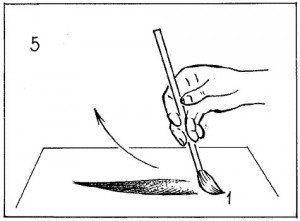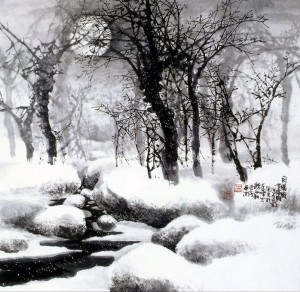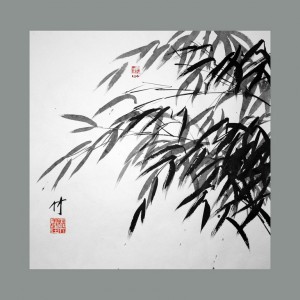Metal in movement is the opposite of wood qualities.
Wood is directness, sharpness, pressure, weight, a dash forward,
whereas metal is flexibility, refinement, and gradual progress. Both
wood and metal have their own rhythms, but that of metal is much
smoother. It manifests in gradual lightening of pressure into finer
brushstrokes. Metal brushstrokes resemble the movements of a snake.
The metal movement results in an elongated brushstroke. It starts with a dot and ends in a sharp point, like the point of a needle, or the tip of a swishing whip, or the blade of a long sword. This brushstroke is used for painting grass, wild orchid leaves, and various snakes. The metal brushstroke is also a great asset when it comes to depicting river rocks and smooth lake water.

Metal in the composition is connected with the tonal contrast. Metal is something that divides. A stronger and more pure tone breaks the weaker tone into parts. If we apply black color to a white sheet of paper, the blackest color will be extreme yang, while grey shades will direct us to the extreme “white yin” space. It’s as if we travel down the tonal steps from the darkest color to the lightest. Metal provides the painting with depth as well as foreground and background. Pure colors and extreme contrast feature only in the foreground where metal is strong yang. The further away, the less contrast there is – metal weakens in the background and becomes more yin. Metal is easier to render in a monochrome painting, same as wood.
Metal stands in opposition to wood and has the opposite effect. Wood excites, while metal brings calm. “Metal” paintings usually evoke a sense of peace. In some people they can evoke sadness.
A painting by Chinese artist Wang Zi Xiu is a good example of a “metal” painting.

Paintings by Andrey Scherbakov


Painting by Olga Kinyova

The metal movement results in an elongated brushstroke. It starts with a dot and ends in a sharp point, like the point of a needle, or the tip of a swishing whip, or the blade of a long sword. This brushstroke is used for painting grass, wild orchid leaves, and various snakes. The metal brushstroke is also a great asset when it comes to depicting river rocks and smooth lake water.

Metal in the composition is connected with the tonal contrast. Metal is something that divides. A stronger and more pure tone breaks the weaker tone into parts. If we apply black color to a white sheet of paper, the blackest color will be extreme yang, while grey shades will direct us to the extreme “white yin” space. It’s as if we travel down the tonal steps from the darkest color to the lightest. Metal provides the painting with depth as well as foreground and background. Pure colors and extreme contrast feature only in the foreground where metal is strong yang. The further away, the less contrast there is – metal weakens in the background and becomes more yin. Metal is easier to render in a monochrome painting, same as wood.
Metal stands in opposition to wood and has the opposite effect. Wood excites, while metal brings calm. “Metal” paintings usually evoke a sense of peace. In some people they can evoke sadness.
A painting by Chinese artist Wang Zi Xiu is a good example of a “metal” painting.

Paintings by Andrey Scherbakov


Painting by Olga Kinyova

Комментариев нет:
Отправить комментарий